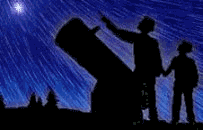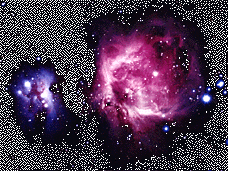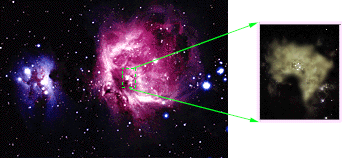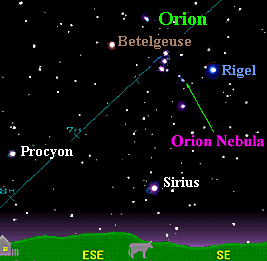 |
 |
| Orion |


This is not what Orion Nebula will really
look like through your telescope, but it looks like this though a cameras time exposure. Pictures of Orion nebule and all other deep space
objects (nebula, galaxies, and star clusters) are taken with time exposures that are able to get the
faintest of details and colors. Your eyes can only see what is bright enough to stimulate the retina
(the back part inside your eye). Most objects are usualy just bright enough to stimulate
only the black and white vision. In brighter objects such as the Orion Nebula a little color
is stimulated in the color we are most sensitive, green. Due to its brightness and because the oxygen in the nebula emits green Orion nebula will have a grayish green color. This Nebula is visable with the naked eye and can be found in the winter through Spring in
the constellation of Orion.

On the left you see a Low magnification full color photograph
of Orion Nebula on the right is an image showing closer to what you would see at high
power through a small telescope. What you will actually see will depend on how dark
your skies are (you can see this even in Los Angles, a very light polluted city), but you will not see Orion look
like the image on the left.

The Orion Nebula in January around 7 - 8 PM. Orion will be visable higher and higher in the late envening
sky until early May where it will set in the west. Also check all around in the neighboring
constelations with binoculars and low power with a telescope.
Image (modified) from Home Planet by John Walker.

Return to the Home Page .







